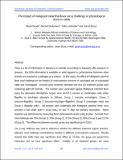| dc.description.abstract | There is a lot of information in literature on animals succumbing to disease(s) after exposure to stressors. But little information is available on what happens to corticosterone hormones when animals are exposed to a pathogen as a stressor. In this study, the effect of Malignant catarrhal fever viral challenge on the kinetics of corticosterone hormone in vaccinated and un-vaccinated cattle was investigated. Animals were randomly allocated into five (5) treatment groups each containing eight (8) animals. The animals were vaccinated against Malignant catarrhal fever using the attenuated Alcelaphine herpes virus AHV1.0 vaccine in combination with either flagellin or emulsigen adjuvants as follows; Group 1 (vaccine +emulsigen), Group 2 (vaccine+flagellin), Group 3 (vaccine+emulsigen+flagellin), Group 4 (emulsigen only) and Group 5 (flagellin only). All animals were challenged with Malignant catarrhal fever virus (virulent C-500 strain AHV-1 virus) tcid50 on day 77 after the primary vaccination. Stress response was determined by measuring fecal corticosterone levels using ELISA. Survival from viral challenge was 75% (Group 1), 50% (Group 2), 37.5% (Group 3), 50% (Group 4) and 12.5% (Group 5). The differences between survival curves was significant (p=0.0182).
The 2-way ANOVA was used to determine whether the different treatment regime (vaccine, adjuvant, viral challenge combinations) resulted in different corticosterone responses. Results showed that while there was significant time effect (p <0.001), the group and group×time interaction did not have significant effect. Initially in all treatment groups, the mean
corticosterone concentrations decreased progressively from baseline to lowest levels on day 56 and then increased sharply to peak levels on day 77 just before viral challenge. However the mean peak levels were significantly higher than baseline levels only in Group 2 (vaccine+flagellin) and Group 5 (flagellin alone). After challenge with live virus, the mean corticosterone levels decreased progressively in all groups from peak levels on day 77 to lowest levels on day 133 and then stabilized. The decrease in corticosterone levels after challenge was however significant in Group 5 only. Compared to peak levels, corticosterone concentrations in group 5 were significantly lower on Day 133 (p<0.05), Day 147 (p<0.001) and Day 161 (p<0.001).
To determine whether there was difference in corticisterone levels between animals that died from the disease and those that survived, the unpaired t-test was used to determine difference. Mean terminal corticosterone hormone metabolites in dead animals (43.36 ± 3.796) was significantly higher (p< 0.05) than in survivors (29.32 ± 4.548) indicating higher stress response in animals with severe clinical signs.
Results from this study demonstrate that Malignant catarrhal fever virus challenge in cattle decreases corticosterone levels but in general corticosterone levels are higher in animals with severe clinical signs of the disease. | en_US |

